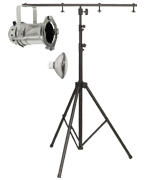The pins are also thicker and thus more difficult to bend...
Given everything is headed to Ethernet anyway, we may never see proper DMX compliance...
Umm, there are plenty of "real" manufacturers who put 3-pin XLR connectors on their DMX controlled gear. For a long time, Martin exclusively use 3-pin, and now they supply both. Doug Fleenor makes opto-splitters in both flavors. It may not technically be compliant with the standard, but that does not mean that the devices are not worth using, many are some of the best devices on the market.
 "In my day we used 5 pin dmx cables and they were expensive! and we liked it. You kids don't know how easy you have it."
"In my day we used 5 pin dmx cables and they were expensive! and we liked it. You kids don't know how easy you have it."From the article cited:Not much has changed on this issue since 1998, when I wrote this article, with some grinding of teeth!
Whose network is it, anyway? Why the end user is the loser in the DMX512 connector controversy
ST
Is work on this still in progress? Does anyone else see the irony in taking eleven years to develop a Compliance Statement to a Standard that took only a few meetings over the summer of 1986?
All you young guys here on CB will be grumpy old T.D.'s saying,
"In my day we used 5 pin dmx cables and they were expensive! and we liked it. You kids don't know how easy you have it."
Someone around here used to say that you could run DMX down a barbed wire fence if you wanted to. My grandfather has 100+ feet of barbed wire fence running along both sides of his driveway. I fully intend on testing that claim when I have the equipment to. (properly terminated of course)
I might make a video and post it.
It's not uncommon for me to say you can run analogue audio over wet string, DMX over barbed wire would depend on length as well as the ambient noise floor in EMR terms, no to mention the atmospheric conditions would have a bearing.
It would be better done with a protocol that has some error checking ability. Watching the error count change as you moved further along the fence could be interesting...
From the article cited:
Is work on this still in progress? Does anyone else see the irony in taking eleven years to develop a Compliance Statement to a Standard that took only a few meetings over the summer of 1986?
Someone grabbed my 3 pin "DMX" cable and put it in with the XLRs. How do I tell which one is the "DMX" cable?
I purchased an Elation Stage Pak 2 for adding lights in our gym for school plays and a worship service they have there on week ends. I wanted to try a temp setup before committing to additional electric work. I used two of the provided 3 pin "DMX" cables connected together to connect between two dimmer boxes. I needed a longer one from the controller to the dimmer in the ceiling so I grabbed an XLR to test things out. Someone came along and picked up the third cable, wound it up, and put it in the XLR box. So how can I tell which one is the "DMX" cable?

We use essential cookies to make this site work, and optional cookies to enhance your experience.

